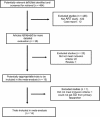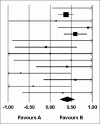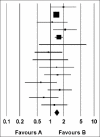A meta-analysis of the relationship between endometrial thickness and outcome of in vitro fertilization cycles
- PMID: 22346080
- PMCID: PMC3276947
- DOI: 10.4103/0974-1208.92287
A meta-analysis of the relationship between endometrial thickness and outcome of in vitro fertilization cycles
Abstract
Objective: The objective was to evaluate the relationship between endometrial thickness on the day of human chorionic gonadotropin administration and pregnancy outcome in in vitro fertilization cycles.
Design: This was a systematic review and meta-analysis.
Materials and methods: We identified 484 articles using Cochrane library, PubMed, Web of Science, and Embase searches with various key words including endometrial thickness, pregnancy, assisted reproductive technology, endometrial pattern, and in vitro fertilization. A total of 14 studies with data on endometrial thickness and outcome were selected, representing 4922 cycles (2204 pregnant and 2718 nonpregnant). The meta-analysis with a random effects model was performed using comprehensive meta-analysis software. We calculated the standardized mean difference, odds ratio (OR), and 95% confidence intervals (CIs).
Results: There was a significant difference in the mean endometrial thickness between pregnant and nonpregnant groups (P<0.001), with a standardized mean difference of 0.4 mm (95% CI 0.22-0.58). The OR for pregnancy was 1.40 (95% CI 1.24-1.58).
Conclusions: The mean endometrial thickness was significantly higher in pregnant women compared to nonpregnant. The mean difference between two groups was <1 mm which may not be clinically meaningful. Although there may be a relationship between endometrial thickness and pregnancy, implantation potential is probably more complex than a single ultrasound measurement can determine.
Keywords: Assisted reproductive technology; endometrial pattern; endometrial thickness; in vitro fertilization; pregnancy.
Conflict of interest statement
Figures
Similar articles
-
Relationships between pregnancy rates following in vitro fertilization or intracytoplasmic sperm injection and endometrial thickness and pattern.Eur J Obstet Gynecol Reprod Biol. 2005 Jun 1;120(2):179-84. doi: 10.1016/j.ejogrb.2004.08.016. Eur J Obstet Gynecol Reprod Biol. 2005. PMID: 15925048
-
The impact of intentional endometrial injury on reproductive outcomes: a systematic review and meta-analysis.Hum Reprod Update. 2019 Jan 1;25(1):95-113. doi: 10.1093/humupd/dmy034. Hum Reprod Update. 2019. PMID: 30388238
-
The detrimental effect of increased endometrial thickness on implantation and pregnancy rates and outcome in an in vitro fertilization program.Fertil Steril. 1999 Jan;71(1):147-9. doi: 10.1016/s0015-0282(98)00413-0. Fertil Steril. 1999. PMID: 9935132 Clinical Trial.
-
Endometrial thickness dynamics and morphologic characteristics during pituitary downregulation with antagonists in assisted reproductive technology cycles.J Ultrasound Med. 2008 Nov;27(11):1591-6. doi: 10.7863/jum.2008.27.11.1591. J Ultrasound Med. 2008. PMID: 18946098
-
The efficacy of intrauterine injection of human chorionic gonadotropin before embryo transfer in assisted reproductive cycles: Meta-analysis.J Int Med Res. 2015 Dec;43(6):738-46. doi: 10.1177/0300060515592903. Epub 2015 Sep 10. J Int Med Res. 2015. PMID: 26359294
Cited by
-
The effect of endometrial thickness on pregnancy outcomes of frozen-thawed embryo transfer cycles which underwent hormone replacement therapy.PLoS One. 2020 Sep 24;15(9):e0239120. doi: 10.1371/journal.pone.0239120. eCollection 2020. PLoS One. 2020. PMID: 32970718 Free PMC article.
-
Effect of intrauterine perfusion of granular leukocyte-colony stimulating factor on the outcome of frozen embryo transfer.World J Clin Cases. 2021 Oct 26;9(30):9038-9049. doi: 10.12998/wjcc.v9.i30.9038. World J Clin Cases. 2021. PMID: 34786386 Free PMC article.
-
Effect of gonadotropins and endometrial thickness on pregnancy outcome in patients with unexplained infertility or polycystic ovarian syndrome undergoing intrauterine insemination.J Int Med Res. 2020 Oct;48(10):300060520966538. doi: 10.1177/0300060520966538. J Int Med Res. 2020. PMID: 33121310 Free PMC article.
-
Endometrial Infusion with Plasma Rich in Growth Factors (PRGF) in IVF Cycles: Randomized Clinical Trial in Very Thin Endometrium and Observational Uncontrolled Follow-Up After the Randomized Clinical Trial.J Clin Med. 2025 Mar 13;14(6):1952. doi: 10.3390/jcm14061952. J Clin Med. 2025. PMID: 40142760 Free PMC article.
-
A critical appraisal of studies on endometrial thickness and embryo transfer outcome.Reprod Biomed Online. 2023 Oct;47(4):103259. doi: 10.1016/j.rbmo.2023.103259. Epub 2023 Jul 3. Reprod Biomed Online. 2023. PMID: 37516058 Free PMC article. Review.
References
-
- Frydman R, Testart J, Giacomini P, Imbert MC, Martin E, Nahoul K. Hormonal and histological study of the luteal phase in women following aspiration of the preovulatory follicle. Fertil Steril. 1982;38:312–7. - PubMed
-
- Cohen JJ, Debache C, Pigeau F, Mandelbaum J, Plachot M, de Brux J. Sequential use of clomiphene citrate, human menopausal gonadotropin and human chorionic gonadotropin in human in vitro fertilization. II. Study of luteal adequacy following aspiration of the preovulatory follicles. Fertil Steril. 1984;42:360–5. - PubMed
-
- Garcia JE, Acosta AA, Hsiu JG, Jones HW., Jr Advanced endometrial maturation after ovulation induction with human menopausal gonadotropin/human chorionic gonadotropin for in vitro fertilization. Fertil Steril. 1984;41:31–5. - PubMed
-
- Friedler S, Schenker JG, Herman A, Lewin A. The role of ultrasonography in the evaluation of endometrial receptivity following assisted reproductive treatments: A critical review. Hum Reprod Update. 1996;2:323–35. - PubMed
LinkOut - more resources
Full Text Sources



